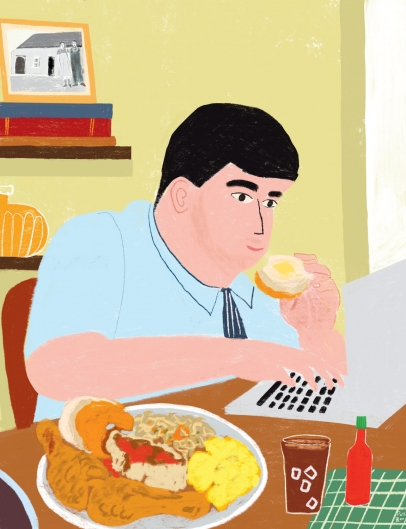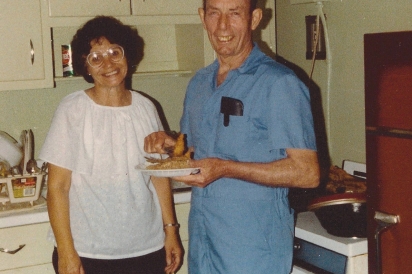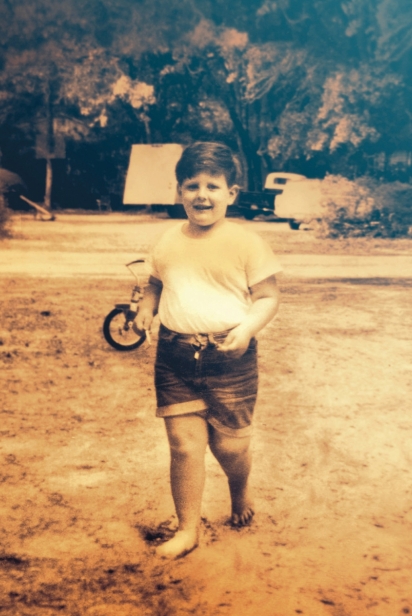We The People are Larger Than We Used to Be
THAT INCLUDES ME AND A WHOLE NATION OF NOW SEDENTARY WORKERS
This work is reprinted by permission from the Winter 2019 issue of Gravy, a publication of the Southern Foodways Alliance. SouthernFoodways.org.
I was born in 1964 to a man and a woman who worked their whole lives with their backs and their hands.
My folks, L.M. and Virginia Tomlinson, grew up a few counties apart in South Georgia during the Depression. Their families were sharecroppers, picking cotton in fields that belonged to wealthier men. My mom quit school in the fourth grade and my dad quit in the sixth. They were full-time farm workers from the time they were nine or ten years old. They picked the cotton bolls from the pods that bit into their fingers. They dragged the ever-heavier sacks down the rows. They bent over all day, the sun beating down on top of them, turning them into rednecks—not by choice, or by culture, but by the brutal facts of their work.
They both got out of the fields as fast as they could. My dad spent a little time in the Army, came back and worked as a logger for a dollar a day, then got a job at an appliance repair shop, where he learned how to fix bigger and bigger machines. My mom took care of her mom, worked a bunch of odd jobs, got in and out of a bad marriage. Eventually they both found jobs at a seafood plant called SeaPak on St. Simons Island, Georgia. That’s where they met. When they got married in 1963, my dad had a cast on his left hand from getting it mangled in one of the machines he worked on. They bought a house with a mortgage of 50 dollars a month, and not long after they had me.
In a picture from the early ’70s, my daddy is holding a plate of catfish. We caught thousands of those fish out of the Altamaha River when I was growing up. If you came to our house on a Saturday night back then, more than likely you were getting fed fried fish, French fries, hushpuppies, slaw, sweet tea and banana pudding. We also caught crabs with chicken necks and threw cast nets for shrimp. Years later, when I came home and told my mama that shrimp and grits was going for twenty dollars a plate in Charleston, she refused to believe it. For us, shrimp and grits is what we ate if there was nothing else left in the house.
As you can see, my mama and daddy were average-sized people. He stayed right around 175 pounds his whole adult life. I am slightly different. Five years ago, when I started working on my book, I weighed in at 460. Now, over the years, I piled on the fast food and pizza and beer in a way my folks never did. But growing up, I ate the same Southern food they did, and I kept getting bigger while they stayed the same.
What I want to talk about today is why that food landed on me in a way that it didn’t on them. I think it has a lot to do with why America is getting bigger as a whole—depending on how you measure it, up to 40 percent of the people in this country qualify as medically obese.
A big part of that, I think, is the shift over generations from blue-collar work to white-collar work. In short: Workers in this country used to spend the day on their feet. Now most of us spend it sitting on our asses. And as a result, we the people are a lot larger than we used to be.
The U.S. Bureau of Labor Statistics measures work in categories that lump together people who move around for work and people who don’t. For example, the service category includes places like hotels. In a hotel, you’ve got people sitting at desks taking reservations, and you’ve got people on their feet all day cleaning rooms and washing sheets. So any measure of desk work versus muscle work is bound to be imprecise.
But one standard measurement is to look at what they call goods-producing jobs— those that involve something tangible getting made. The government groups those kinds of jobs into four main categories: agriculture, manufacturing, construction and mining.
A lot of agricultural labor has been consolidated into factory farms that use machines to do what people used to. And manufacturing jobs have been lost to automation or shipped overseas. But let me illustrate just how profound a change it’s been.
Let’s go back two generations, to 1950. My dad would have been working for a while by then and my mom would’ve been just entering the work force. That year, those goods-producing jobs—blue-collar work—made up 41 percent of all the jobs in the United States.
Now fast-forward to 1986, when I got out of college and started working in a desk job as a newspaper reporter. By that year, the percentage of goods-producing jobs nationwide was down to 25 percent.
And today, in 2019, those goods-producing jobs are down to less than 15 percent. So when my mom and dad were young working people, about two out of every five Americans did physical labor. Now it’s about one in seven.
So here’s a second set of numbers.
By the time my parents were out in the workforce, around 1960, the average American man weighed 166 pounds, and the average American woman came in at 140.
In the mid-1980s, the average American man weighed 181, or 15 pounds heavier. The average American woman was up 13 pounds, to 153.
Currently, the average American man weighs in at 198, and the average American woman is 171.
So men are 32 pounds heavier on average than we were two generations ago, and women are 31 pounds heavier. The good news is, we’re also an inch or so taller. But we’re getting wide a lot faster than we’re getting high.
Why? Fast food and junk food are more available and cheaper than they’ve ever been before. They are advertised relentlessly. And more people than ever live in places where it’s hard to find fresh fruits and vegetables.
But we have to remember that our bodies are not just a reflection of what we eat, but a reflection of how we live when we’re not at the table. And I’d argue that this fundamental shift in how we spend our work days— basically, from active work to passive work—has contributed to that change as much as anything. And I know this for a fact to be true in my own family.
My grandmother had a stroke when my mom was 12 years old. So from then on, my mom was in charge of the household for her mom and the five other remaining kids. Every morning she got up and made three dozen biscuits with white gravy—basically, flour and bacon grease. Those seven people would eat every one of those biscuits—five or six apiece. Then, before she went back in the field, she’d start a big pot of black-eyed peas or lima beans. That would be lunch and supper, augmented by two or three skillets of cornbread per meal. On better days, they’d have a hunk of ham or some fried chicken. But biscuits and beans was their regular sustenance, day after day after day.
I added it up one day and figured that eight or ten biscuits and hunks of cornbread, a few tablespoons of gravy, plus three cups of black-eyed peas or limas, comes to about 4,500 calories—roughly double the recommended intake for an average person now. The food was cheap and monotonous, but it was full of carbs and protein. They needed every last calorie to survive fifteen-hour days bent over a cotton patch in the Georgia summer.
As a result, everybody in my family from my mom and dad on back were as lean and strong as deer. The only one I ever saw with a potbelly was my Uncle Junior, who got into the exterminating business and did well enough that he could pay other people to crawl under houses. Otherwise, if you lined up my mom and dad and their brothers and sisters and cousins, it would look like the starting line of a triathlon. None of them had ever been to a gym. Their lives were a gym. Nothing you could do at the YMCA could ever replicate the workout they went through every damn day.
As my parents’ generation moved off the farm, and mostly out of poverty, supper improved greatly. They sampled some modern foods. I barely remember a day growing up when our refrigerator did not contain a glass bowl full of Jell-O. But the core of what they ate, and eventually what I ate, was what we think of as traditional Southern food.
Most of the time, the center of the table was a platter of fried chicken piled so high it would topple if you pulled out the wrong leg. There’d be pork chops, turkey and dressing, beef stew, maybe venison if it was hunting season. Then the white food group: mashed potatoes, potato salad, deviled eggs, rice with brown gravy. Biscuits and cornbread shining with butter. And then the vegetables: Crowder peas and Kentucky Wonder pole beans, crookneck squash and fried okra, turnip greens in salty potlikker, sliced tomatoes picked five minutes ago.
This paragraph is as close as I will ever come to writing porn.
But without any of us paying much attention, the shift in the way we worked had already started. My brother, who’s fourteen years older than me, was the first in my family to go to college; he eventually became an insurance agent. My sister became a social worker. I still had cousins who ended up at the pulp mill or the chemical plant. But my people were slowly transforming from farmers and factory workers to teachers and salespeople, and even a writer.
Here’s me, at 4 years old, already the beneficiary of a few of those family reunions. That kid is not about to run a triathlon.
Back then, when my dad would finish his shift at SeaPak, he’d stop by the canteen on the way out the door and buy a carton of chocolate milk and a pack of peanut butter crackers. He’d bring them home to me every night, like a sacrament. I was too young to remember him doing it. As my mom and dad told the story over the years, I thought of the milk and crackers as a treat, a nightly gift from a man who spoke with his actions more than his words.
But lately I’ve also come to think of it as my dad’s insurance policy. He knew what it was like to go hungry. And he wanted to make sure that was something his son would never know.
By then, those big meals we were eating carried a double meaning.
The Southern supper table was, for most of my family’s history, nothing more than a gas station—where they fueled up for the next shift of the backbreaking work they had to do to hold things together.
But as the years went by, that food also has also become a symbol of what all those working people overcame. Now, it serves as a love offering from our laboring past into the 9-to-5 present where most of us live.
Sometimes a cigar is just a cigar. But in my house, a piece of chicken was rarely just a piece of chicken.
That is delicate territory, emotionally and physically.
My parents’ bodies operated in a fundamentally different way than mine. They worked so hard for so long that their metabolism revved like a cheetah’s. Mine is more like a manatee. And so when we ate those big meals, my family could shed those calories, but they stuck to me. And I became hooked on food in a way they didn’t. As I got older, I augmented those meals with Big Macs, pizza, beer and Little Debbies by the box.
One of the things I’ve found out through research and writing is that something down deep in our DNA thinks we’re still cave people. If you’re overweight like me, and you lose a lot of weight really fast, it sets off alarms at the cellular level. Your body thinks you’re wasting away. So it slows your metabolism down and increases your appetite, encouraging you to eat something because winter is coming. That leads to a brutal paradox: The more weight you’ve gained, the harder your body fights you when you try to lose it.
These days, if you lined up my family for a photo, we wouldn’t look like the starting line of a triathlon. Maybe the starting line of a hotdog- eating contest. The soft work my generation does, combined with those rich meals, brings its own set of consequences.
My sister died at 63 from an infection brought on by her chronic weight problems. At her funeral, I remember looking around at all the people I knew—all our family and friends—and realizing that they’d be back soon for my funeral if I didn’t do something soon.
So I have spent the past few years on a slow and steady program to drop a little weight every month, enough to feel better and be healthier, but not enough to set off those alarm bells in my DNA. I’ve learned to take smaller portions, or save up for special meals, or just walk away. That’s not always easy, especially when your family gathers, and your aunt has made the special mac and cheese she makes just once a year, and it is so fucking good.
This body I carry around is the accumulation of thousands of bad decisions over my 55 years. But it is also, in some strange way, a symbol of victory. I don’t want to be fat, and I am working hard so that one day I won’t be fat anymore.
But nobody in my family before me had the luxury to choose. They worked so hard to survive—but also to make sure we wouldn’t have to work as hard as they did. And they succeeded. My life is easier, by any measure, than the life my parents had to live. No matter how high I climb, I will never have to travel as far as they did to make it out of the dust of the cotton fields.
My mother, until her dying day, would hide her eyes every time we passed a cotton patch. Every once in a while, my dad would crave biscuits and syrup for supper, and my mom would make a pan of biscuits, because she loved him. But after he did, she announced that she was done making biscuits. She had made enough for one life.
Three years ago, I gave up fast food for Lent. Since then, I haven’t been in a McDonald’s or Burger King or any of those places, except to use the bathroom. The last fast-food meal I had was with my mom. I had taken her to the doctor’s office and on the way back she was hungry. She wanted a biscuit. So we went to Hardee’s and that’s what we got. The biscuit she ate landed in her body differently than mine did. It probably also landed in her mind in a different way. That biscuit, and thousands of others like them, meant survival for her. Avoiding that biscuit, and thousands of others like them, has meant survival for me.







